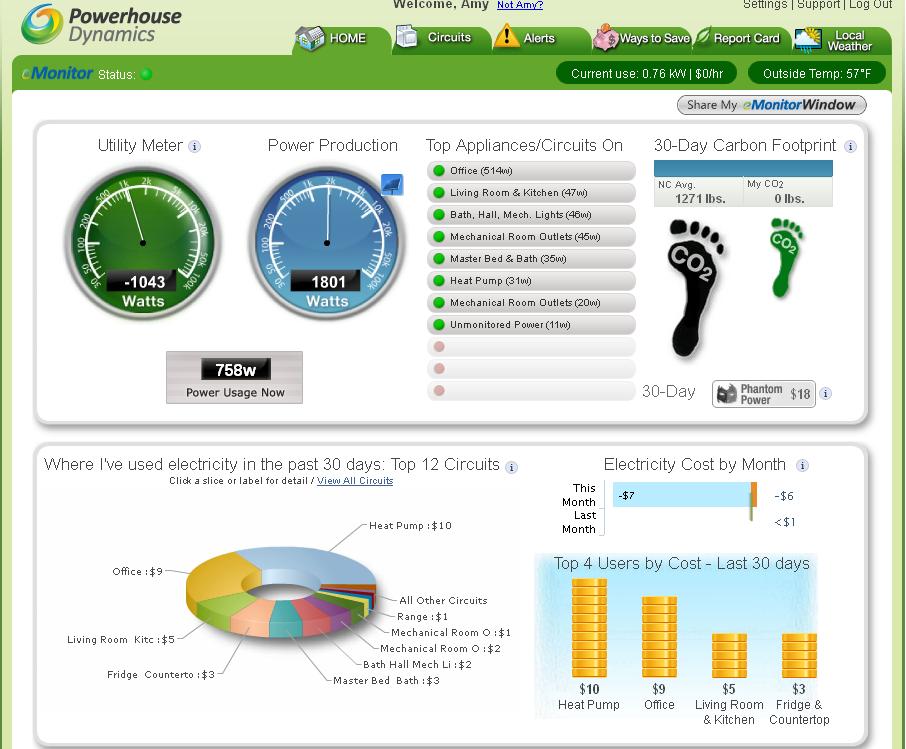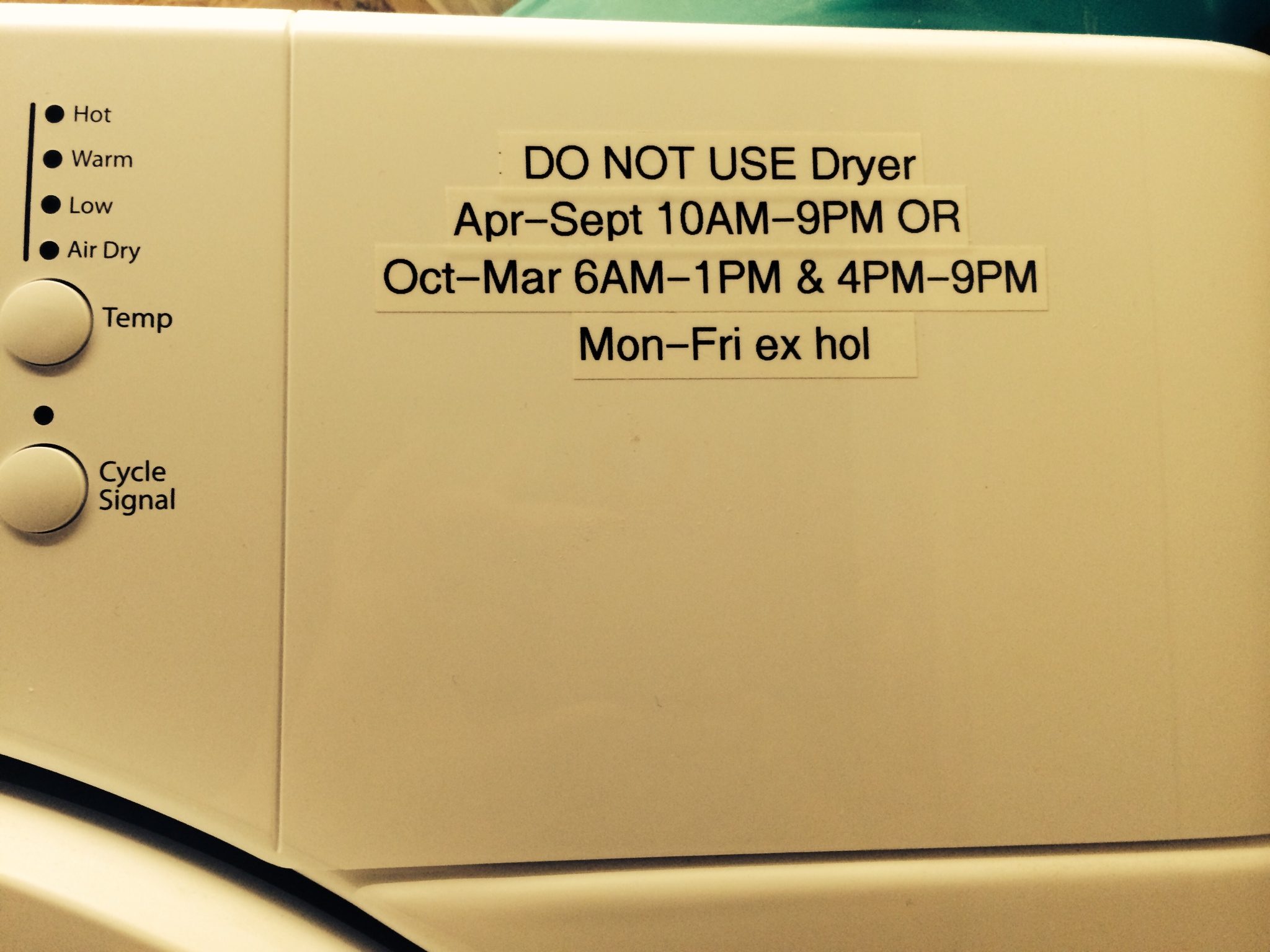Thinking about installing solar PV in Western NC? You’ll need to learn about the locally available utility buy-back agreements and decide which one is right for you. We’re fortunate in the Asheville area to have the Duke Energy Progress Sunsense program. It’s a great program in many ways, but it’s not right for everyone. We’ve been on the program for nearly 3 years and have been very successful with it. And I’m going to tell you how you can be too.
The Sunsense agreement is really complicated. I make a living estimating energy use and cost savings for other people, and it’s so complex that the best I could estimate was that our array would pay back in 5-12 years. In practice, I think it’s going to be closer to 5. About 80% of that payback happened in the first two years: federal and state tax credits and an upfront cash rebate from the utility company. The rest will slowly accumulate as long as we’re successful at keeping our bills low.
At the risk of causing your eyes to glaze over, there are a few key components of Sunsense that you need to understand if you’re going to be successful. These are:
- Upfront cash rebate: $500 per kW
- Monthly bill credit (first 5 years): $4.50 per kW
- Net metering usage and production rates: Net metering means that at any moment in time you are either selling power or buying power, but not both. When you’re using less electricity than you’re producing, you sell the excess. When you’re making less than you’re using, you buy the difference. You buy and sell at the same rate, which is about 10 cents per kWh.
- Demand charge: You also pay a fee every month for your highest on-peak electricity demand. This is the highest amount of power (in kW) that you use at any moment in time. So if, for instance, your water heater, heat pump, clothes dryer, plasma TV, oven, and electric car are all using power at the same time at 4:30 in the afternoon one day you’ll pay a separate fee that month for this peak power use.
Of these, the demand charge is the biggest wild card. Demand charges are common for commercial power customers, but most residential customers have never paid for peak power demand before and are not used to thinking about peak power usage. Peak demand can be difficult to predict in advance and this is why I wasn’t able to estimate my payback period very accurately.
If you’re a numbers-type person, there are a few somewhat less important nuances that you’re also going to want to know about. (Everyone else please skip this paragraph!)
- Usage (kWh) rates vary between on and off-peak times.
- On-peak times are 10:00 AM to 9:00 PM in the summer, and 6:00 AM to 1:00 PM and 4:00 PM to 9:00 PM in the winter.
- Your demand charge only applies to peak demand during on-peak hours.
- Power generated on-peak can be used to offset on or off-peak power usage. Power generated off-peak can only offset other off peak power. (This doesn’t matter as much as you think it might, because you’re going to generate a lot of on-peak power.)
- Excess production in your account is reset to zero annually in May. (This means that you want to size your array to get as close to net-zero as you can without becoming a net-producer. Since you’ll make more power in the summer, this is actually not a bad time for them to reset your account.)
- There’s a $10 per month service charge to have electric service.
At the risk of cribbing from Alcoholics Anonymous, my 3-step program will help you succeed on Sunsense.
Step 1: Acknowledge that you have a problem.
You actually have two problems, and they’re the same ones everyone else has. You have a lot of stuff plugged in and some of it uses “vampire” power all the time even if you aren’t using it. And you’re probably blissfully unaware of exactly how much energy your favorite appliances use. If you’re going to be on Sunsense, you need to change that.
Get an energy monitor. I have Site Sage and love it – it has a slick interface and is very easy to understand. It shows me my energy use by circuit in real time and tells me what my big users are. It tells me which circuits have phantom power. You could also get by with a simpler whole-house monitor like the TED, but you’ll need to do a little more legwork to unplug things and see what that does to the whole house usage.

Vampire loads are adding to your power use all the time. In addition to being totally wasteful, they add to your peak power use. So by cutting them out you save two ways: you save on power usage and you save on your demand charge.
The monitor will also show you which of your devices use the most energy when they’re plugged in. You’ll finally know whether your toaster uses more energy than your clothes dryer (it’s the dryer).
Step 2: Accept the things you can’t change.
There are certain things that are going to have to use power during peak periods. You’re not going to be able to schedule your cooking for off-peak times. Your heating and air conditioning are going to have to operate. You’re going to use your computer and lights and generally live in your house like a normal human being. This isn’t worth getting a divorce or putting your kids into therapy.
Remember that your demand charge is based on your peak usage for the whole month. Close is not good enough. That one day you slip up is what you’re going to pay for. But you can start over with a clean slate next month.
Step 3: Change the things you can.
There are other big power users that are pretty easy to delay to off-peak times. Weekends and holidays are always off-peak, so simply committing to doing certain tasks only on the weekend is an easy way to lower your demand charge. The best example is your clothes dryer. I pretty much only have time to do laundry on the weekend anyway, so if I need to use the dryer it’s OK. In case of an emergency mid-week load, I have a sticker on my dryer that tells me what the on-peak times are so that I can avoid using it at that time. It’s just not that big of a deal for me.

Make a list of the big power users you can shift to off-peak . If you have an electric car, a kiln, or other big electricity-using hobby, it will have to be off-peak if you’re going to succeed with Sunsense. The clothes dryer is pretty important.
If you have an electric water heater, it would be best to shift that. I have electric backup to my solar water heating and I have it on a timer. 4:00 – 5:00 AM is always off-peak, so I only let the backup run for that one hour. We have an 80 gallon tank, so we never run out of hot water. Any electric water heater can be put on a timer. Get an electrician to install one and program it for off-peak times. If you have a lot of people and a small water heater, this could get tricky, but most people are never going to notice the difference.
You probably can’t lock out any part of your heating system, but there are some exceptions. I have a geothermal system that uses an electric resistance backup in case it ever gets so cold that my heat pump can’t keep up. I worked with my system’s installer to lock out the backup so that I’d manually have to turn it on. If my system dies or the next ice age happens, I’ve got backup. But I also know that the backup won’t come on accidentally one morning at 9 AM and ruin a months’ worth of low electricity demand. If you have an air-source heat pump, you’re not going to be able to do this. They run on backup a lot more often and you need that heating.
Step 4. Relax.
Yes, this is all complicated, but it’s really not that bad. You’re going to spend a little time on a learning curve while you become a little more aware of how you use electricity. That’s not a bad thing. Everyone should be educated about this! And you’re going to make a couple stickers to remind you when to use things like your dryer. You’re going to automate your water heater. Once you get that done, it becomes second nature and you don’t think about it. You’ll keep tabs on your electricity bills and make sure nothing’s going awry. You’re not going to yell at your kids or spouse for plugging in their cell phone or making toast during on-peak electricity times.
And you’ll probably succeed. Most months, we have enough banked power to cover our usage charges. Our per kW bill credit usually just about covers our demand charge and some of the service charge. There are plenty of months when our bill is only a few dollars. Just before the May reset we often have a month or two when we run out of banked usage and the power bill might be $30. Totally worth it.
Copyright 2014. Amy Musser

